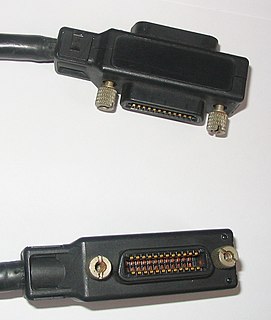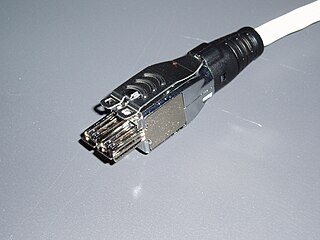Related Research Articles

MPEG-2 is a standard for "the generic coding of moving pictures and associated audio information". It describes a combination of lossy video compression and lossy audio data compression methods, which permit storage and transmission of movies using currently available storage media and transmission bandwidth. While MPEG-2 is not as efficient as newer standards such as H.264/AVC and H.265/HEVC, backwards compatibility with existing hardware and software means it is still widely used, for example in over-the-air digital television broadcasting and in the DVD-Video standard.

IEEE 488 is a short-range digital communications 8-bit parallel multi-master interface bus specification developed by Hewlett-Packard as HP-IB. It subsequently became the subject of several standards, and is generically known as GPIB.
AES3 is a standard for the exchange of digital audio signals between professional audio devices. An AES3 signal can carry two channels of PCM audio over several transmission media including balanced lines, unbalanced lines, and optical fiber.
IEC 60027 is a technical international standard for letter symbols published by the International Electrotechnical Commission, comprising the following parts:
mLAN, short for Music Local Area Network, is a protocol for synchronized transmission and management of multi-channel digital audio, video, control signals and multi-port MIDI over a network.
In electrical engineering and power system automation, the International Electrotechnical Commission 60870 standards define systems used for telecontrol. Such systems are used for controlling electric power transmission grids and other geographically widespread control systems. By use of standardized protocols, equipment from many different suppliers can be made to interoperate. IEC standard 60870 has six parts, defining general information related to the standard, operating conditions, electrical interfaces, performance requirements, and data transmission protocols. The 60870 standards are developed by IEC Technical Committee 57.

The Telecommunications Industry Association (TIA) is accredited by the American National Standards Institute (ANSI) to develop voluntary, consensus-based industry standards for a wide variety of Information and Communication Technologies (ICT) products, and currently represents nearly 400 companies. TIA's Standards and Technology Department operates twelve engineering committees, which develop guidelines for private radio equipment, cellular towers, data terminals, satellites, telephone terminal equipment, accessibility, VoIP devices, structured cabling, data centers, mobile device communications, multimedia multicast, vehicular telematics, healthcare ICT, machine to machine communications, and smart utility networks.

TERA is a shielded twisted pair connector for use with Category 7 twisted-pair data cables, developed by The Siemon Company and standardised in 2003 by the International Electrotechnical Commission with the reference IEC 61076-3-104. The 2006 revision of the standard extended the characterised performance up to 1000 MHz. The connector has a different footprint from the more common 8P8C connector.
IEC 62379 is a control engineering standard for the common control interface for networked digital audio and video products. IEC 62379 uses Simple Network Management Protocol to communicate control and monitoring information.
IEC 60870 part 6 is one of the IEC 60870 set of standards which define systems used for telecontrol in electrical engineering and power system automation applications. The IEC Technical Committee 57 have developed part 6 to provide a communication profile for sending basic telecontrol messages between two systems which is compatible with ISO standards and ITU-T recommendations.
The Standardization Administration of the People's Republic of China is the standards organization authorized by the State Council of China to exercise administrative responsibilities by undertaking unified management, supervision and overall coordination of standardization work in China. The SAC represents China within the International Organization for Standardization (ISO), the International Electrotechnical Commission (IEC) and other international and regional standardization organizations; the SAC is responsible for organizing the activities of the Chinese National Committee for ISO and IEC; the SAC approves and organizes the implementation of international cooperation and the exchange of projects on standardization.

IEEE 1394 is an interface standard for a serial bus for high-speed communications and isochronous real-time data transfer. It was developed in the late 1980s and early 1990s by Apple in cooperation with a number of companies, primarily Sony and Panasonic. Apple called the interface FireWire. It is also known by the brands i.LINK (Sony), and Lynx.
IEC 62455 is an International Electrotechnical Commission terminal specification standard, prepared by the IEC 100 Technical Committee (TC), for a service purchase and protection system for digital broadcasts. Its full title is Internet protocol (IP) and transport stream (TS) based service access. This 18Crypt technology aimed to compete the Open Security Framework (OSF) has never been successful in the market where less than 10 000 deployed devices were using it. On the opposite, the OSF aimed as an open approach enabling wider competition has been widely deployed in millions of devices and re-used in many standards like in the USA or in China.
In 2009, a European Commission initiative resulted in the specification of a common external power supply for use with data-enabled mobile phones sold in the European Union. The external power supply is the AC electric power adapter that converts household AC electricity voltages to the much lower DC voltages needed to charge a mobile phone's internal battery. Although compliance is voluntary, a majority of the world's largest mobile phone manufacturers agreed to make their applicable mobile phones compatible with Europe's common external power supply specification.
ISO/IEC JTC 1/SC 25 Interconnection of information technology equipment is a standardization subcommittee of the Joint Technical Committee ISO/IEC JTC 1, of the International Organization for Standardization (ISO) and the International Electrotechnical Commission (IEC), which develops and facilitates standards within the field of interconnection of information technology equipment. The international secretariat of ISO/IEC JTC 1/SC 25 is the Deutsches Institut für Normung (DIN) located in Germany.
ISO/IEC JTC 1/SC 29 Coding of audio, picture, multimedia and hypermedia information is a standardization subcommittee of the Joint Technical Committee ISO/IEC JTC 1 of the International Organization for Standardization (ISO) and the International Electrotechnical Commission (IEC), that develops and facilitates international standards, technical reports, and technical specifications within the field of audio, picture, multimedia, and hypermedia information coding. The international secretariat of ISO/IEC JTC 1/SC 29 is the Japanese Industrial Standards Committee (JISC) located in Japan.
ISO/IEC JTC 1/SC 6 Telecommunications and information exchange between systems is a standardization subcommittee of the Joint Technical Committee ISO/IEC JTC 1 of the International Organization for Standardization (ISO) and the International Electrotechnical Commission (IEC), that develops and facilitates standards within the field of telecommunications and information exchange between systems. ISO/IEC JTC 1/SC 6 was established in 1964, following the creation of a Special Working Group under ISO/TC 97 on Data Link Control Procedures and Modem Interfaces. The international secretariat of ISO/IEC JTC 1/SC 6 is the Korean Agency for Technology and Standards (KATS), located in the Republic of Korea.
IO-Link is a short distance, bi-directional, digital, point-to-point, wired, industrial communications networking standard used for connecting digital sensors and actuators to either a type of industrial fieldbus or a type of industrial Ethernet. Its objective is to provide a technological platform that enables the development and use of sensors and actuators that can produce and consume enriched sets of data that in turn can be used for economically optimizing industrial automated processes and operations.

Audio Video Bridging (AVB) is a common name for the set of technical standards which provide improved synchronization, low-latency, and reliability for switched Ethernet networks. AVB embodies the following technologies and standards:
References
- ↑ https://webstore.iec.ch/preview/info_iec61883-1%7Bed3.0%7Den.pdf%7C IEC 61883-1 preview